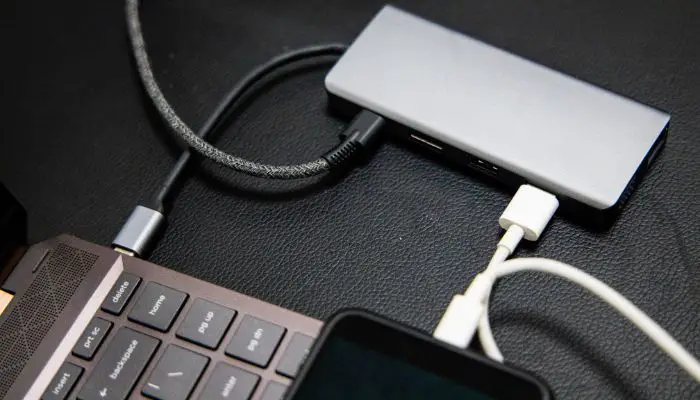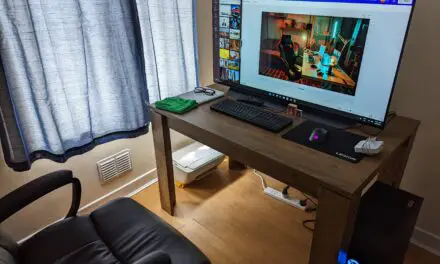If you’re a first-time freelancer or just starting on a work-from-home career, you may have a laptop and no desktop, or both. The idea of turning your laptop into a more permanent workstation is an intriguing one, especially when you can do so without necessarily removing the portability factor.
Docking stations are designed to turn your laptop into a permanent workstation, with more hubs, connection points between monitors, and a superior charging mechanism that might be enough to equal the charger that came with your desktop.
In other words, docking stations are great for those who are on the fly but also need to have access to a desktop-type setup.

Table of Contents
Should I Use A Docking Station?
If you use your laptop for work, a docking station may be worth using as it provides a desktop experience without having to go out and buy a desktop computer. A docking station allows you to connect multiple devices to your laptop allowing you to more easily use it as a work device while cutting down on clutter and the number of cables you need.
To properly answer that question, you should start by asking a few of your own. Do you prefer an “all-in-one” setup? Do you like the idea of getting in from the road and docking your laptop to a permanent workstation set up? Do you want to tie in multiple peripherals, a separate monitor, and maybe a printer?
If you sometimes work from home and sometimes at the office, a docking station can help you create that office setup at home with a laptop.
And if you like to play games on your laptop, you can plug all of your gaming accessories into the docking station so you don’t have to plug and unplug your accessories every time you play. That way, you will only need to connect your laptop to the docking station to be ready to game.
Docking stations also allow you to connect devices to your laptop, like older cameras and TVs, that may not otherwise be compatible.
A docking station is multifaceted both in what it can potentially provide and in its functionality. It also helps to reduce the clutter and turns multiple devices into one, cohesive unit. Printers, multiple monitors, smartphones, your laptop, and more can all be tied to a docking station for easy use.
What Is A Docking Station Used For?
Manufacturers typically design docking stations to work with certain lines of computers. Not every computer can work on the same docking station. Some are created for a wider array of laptops but what they are primarily used for, is to bring together the laptop and potential, other peripherals.
A docking station connects to the laptop and expands its functionality. But the docking station isn’t designed to jump around everywhere your laptop goes, even though you could probably use it that way. It sits where it is, with your favorite or more useful peripherals or devices connected to it.
When you come home, you whip out your laptop and dock it. The docking station is designed to operate with particular lines of laptops and integrates with the laptop in more ways than something like a USB-C hub.
The docking station compiles all of the necessary ports for running all of those peripherals into a single port on your laptop. Some docking stations go beyond just interconnectivity, enhancing your laptop in more ways than it was originally capable, such as audio enhancement.
Does A Docking Station Improve Performance?
A docking station will not improve the performance of your device but in terms of improving capability and therefore improving your productivity level then yes, a docking station will improve performance simply because you can do more with a laptop than if you were using just your laptop without it.
As far as improving your computer’s performance well, your computer can only do what it can do.
For instance, a gaming laptop that can run Red Dead Redemption 2 on high settings is not going to be able to run on ultra or max settings just because you have a docking station on it now.
Once you set your laptop on the docking station, you’re ready to go, with no need to start plugging in extra devices.
Do I Need A Docking Station For Dual Monitors?
It largely depends on what the two monitors support, although using a docking station for two monitors will certainly work. As long as you have a video card that supports dual monitors, you may not need a docking station. Here are two scenarios where you may not need a docking station for dual monitors.
- Existing Computer Ports: If your computer has multiple ports that support monitors, such as a USB-C that can connect to another USB-C, Display Port, or HDMI with an adapter.
- USB-C Hub if you need the ports: Hubs will provide you with the extra ports if you need them and are a fraction of the cost of docking stations.
If you are just looking for a way to connect multiple monitors, then there is no reason to go out and grab a docking station if your video card already supports it.
However, if you want multiple monitors, along with a lot of other ports for various peripherals, then a docking station is the perfect solution.
Is A Docking Station Better Than A Hub?
If you need a professional setup then a docking station will be of better use to you than a hub but if you only need a couple of extra USB ports to charge a phone and connect an external hard drive, a docking station will not be better for you than a hub.
The difference between a docking station and a hub is very small. Both are designed to expand your number of ports. A hub is typically smaller than a docking station and designed to travel with, rather than become your next workstation.
However, you can think of a docking station as an upgrade to a hub. Kind of like the difference between an iPhone 12 Pro and an iPhone 12. They’re both essentially the same phone, but the Pro offers just a bit more functionality.
A hub will expand the number of ports you can use on your device to connect peripherals or charge other devices. Docking stations, on the other hand, are plugged into the mains and transform your device into something that behaves more like a desktop replacement.
Hubs aren’t designed to turn your laptop into a desktop workstation and generally have fewer available ports.
One thing that is being thrown into the mix lately, as if hubs and docking stations weren’t already complicated enough, is the hybrid hub. Hybrid hubs are docking stations in a smaller format, capable of powering your laptop and connecting all of your peripherals at 60Hz and 100W.
Is It Better To Use A Docking Station For A Laptop?
If you want to create a sense of permanence and have a workstation at home, then it makes sense to go with a docking station for your laptop. It’s especially useful for those who bring their work home with them.
You can take your laptop to work and plug it right into a docking station there and when you are done for the day, you can head home knowing that you have a docking station there as well. All you really have to do is plug back in your laptop.
It’s a matter of convenience and hassle-free connectivity. It’s for multitaskers who run multiple screens at the same time and require two monitors. If you just have a laptop for at-home use and it’s primarily for streaming Netflix when you’re bored, then throwing a docking station in the mix makes little sense.
Docking stations remove the drawbacks of portability, working from home and work, gamers who have multiple setups and peripherals, and multitasking.
If none of those things apply to you, then a docking station for your laptop is probably a waste of money.
Related Article: Top 16 Great Reasons To Use A Laptop Stand
Can You Use Any Docking Station With Any Laptop?
Universal docking stations do exist but, for the most part, docking stations are manufactured to work with a select number of computers, such as a series of computers from low end to high end but from the same brand.
While universal docking stations are great, they may lack some of the things that you would get from a docking station that is specifically designed for your laptop.
Also, there’s the fact that most docking stations are also designed to connect with USB-C and Thunderbolt, and not every laptop has those ports.
This is especially true if you have a laptop that is a little older. Time flies and what was state of the art yesterday is ready for the junk pile of history today.
They say that when a brand new, top-of-the-line computer leaves the assembly line for the first time, it is already obsolete.
Can I Use A Docking Station To Switch Between A Laptop And Desktop?
You can do so but you would have to add another accessory called a USB 3.0 Sharing Switch and it can get a little complicated. In a perfect world, you would connect everything from both the desktop and the laptop to a single docking station.
Then, you would connect the docking station to the USB 3.0 Sharing Switch. You would then toggle a switchback (on the USB 3.0) back and forth to switch from the laptop to the desktop and vice versa.
The problem comes with the display. Some USB 3.0 Sharing Switches come with a DisplayLink feature, but if you’re into gaming, then switching to a different monitor is going to create latency issues, as the graphics in one computer is not on the same level with the other, so the video has to be converted on its way to the other screen.
In some cases, it simply won’t work at all, at least when it comes to gaming. DisplayLink will typically be able to handle two different graphical displays as you switch back and forth, so long as you are not doing anything more onerous than using something like Google Docs or Sheets.
The switch works best if you are using a laptop and a desktop and both of them have integrated graphics.
Can You Plug A USB Hub Into A Docking Station?
You can do so but you need to be aware of a couple of potential issues. When you start stacking peripherals, you may run into data transfer speed issues. The second is power consumption.
The typical understanding is that you shouldn’t stack two hubs together, that are unpowered, onto a docking station. Docking stations are typically self-powered and most, if not all, hubs are not.
Most operating systems will give you a warning but that is not always the case. It all depends on what the hubs and the docking station are telling it. The hub might be telling the laptop that it has power, but that’s not the same thing as having “self-provided” power.
Also, when you start daisy-chaining hubs and docking stations, the odds increase that some of the ports along that chain will cease to work altogether.
The truth is, while you might be able to get away with it when it comes to specific setups, it’s best to just stick with the docking station or the hub.
Are There Any Disadvantages To Using A Docking Station?
Most of the disadvantages that you could probably list for having or using a docking station are all situational. In other words, it’s only a disadvantage if a docking station is not suitable for your setup.
- Laptops have different power consumption needs and the docking station may not match that (assuming it is a power-providing docking station)
- They can often be confusing for customers who are casual computer users or simply use their laptops for work
- Not all docking stations work with all laptops and operating systems, which is another point of confusion
Mostly it’s simply a matter of educating yourself and doing your homework before you go out and drop some serious cash on a high-end docking station that you might not need.
As we mentioned, many of the disadvantages are situational, not necessarily true disadvantages.
Are Docking Stations Obsolete?
Docking stations have not reached a point where they are obsolete. At least, they haven’t yet.
Laptops are some way off from being able to simultaneously connect a monitor, keyboard, mouse, printer, hard drive, LAN networks, and other things needed to create a workstation from your portable device without the need for a docking station.
Will there come a point and time when docking stations are obsolete? Most likely but it will be some time off. As laptops become more advanced, with more ports and ports that are multifaceted, there becomes less and less need for a docking station.
Is There Anything I Can Use Instead Of A Docking Station?
You might be surprised at what you do and do not need. If you just want to tie in a few peripherals and you are a port or two short, then a small USB-C hub is probably all you will need.
If you want to multitask with dual monitors, a standard printer, a 3D printer, and the tablet you are using for graphics design, then you should probably consider a docking station, so you can tie all of those things together without your work area looking like Spiderman forgot to turn his web slingers off.
All Things Considered
There is a lot to love about docking stations because if you have a complicated setup in terms of all of your devices, the addition of one can save you a lot of headaches. Then again, maybe all you need is a hub.
If you want to turn your portable situation into a scenario where you can set your laptop down, plug it in with a single cord, and have your entire work life at your fingertips, then a docking station is right up your alley.



